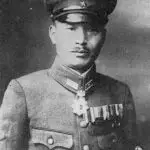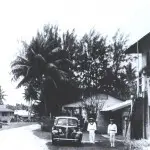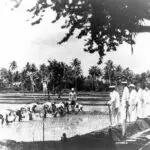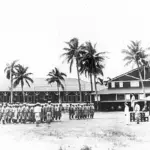Japanese Occupation of Guam
Table of Contents
Share This
8 December 1941 attack on Guam begins
The outbreak of the Pacific War began with Japan’s attack on Pearl Harbor on 8 December (7 December in Hawai’i) 1941 with a subsequent air attack on US military facilities on Guam. In the early hours before dawn on 10 December 370 land combat unit members of the Japanese Navy and 2,700 soldiers of the Army’s South Seas Detachment landed on Guam at five bays: Ylig, Malesso’, Humåtak, Tumon, and Hagåtña.
After the US Navy and the Guam Insular Force fought back at the Plaza de España in Hagåtña for about a half hour, US Naval Captain George J. McMillin, Governor of Guam, surrendered at 5:45 am and signed a letter of surrender at 6 am on the same day.
Island of the Imperial Court
Guam, a “Pearl in the Western Pacific” or the “Island which secretly held America’s ambition”, as the Japanese called it, was renamed to Ômiyajima (Ômiyatô) or “the island of the Imperial Court” by the Japanese Navy.
The Japanese landing operation and US resistance resulted in twenty-one deaths (fourteen Americans and seven CHamorus/Chamorros). One death and six wounded on the Japanese side were reported. Thirty-five Japanese residents who had immigrated to Guam in the pre-war period and were imprisoned when the governor received news of the attack of Pearl Harbor, were released.
Some 483 prisoners of war (POWs) that included 368 military personnel and 115 civilians, including American Catholic priests, were interned at the Saint Vicente de Paul building at Hagåtña and later sent to the Zentsûji POW camp at Kagawa, Japan.
Believing all Americans had been captured, the Japanese Navy informed their headquarters in Tokyo that Guam was secure. However, six American military personnel remained in hiding, and this became a very serious issue for the navy forces. They would have to take the blame for this mistake because it meant that the island was not secure.
After an intensive search, three escapees were found and executed in September 1942 and two others were found and shot in October of that same year. Only US Navy radioman first class George Tweed eluded capture and was finally rescued by a US Navy ship ten days before the 21 July 1944 US landing on Guam. Tweed’s status, as a US military holdout, was a most serious matter for the Japanese Navy during the entire occupation period of thirty one months.
Greater East Asia Co-prosperity Sphere
According to Japan’s proclamation of war, the war’s purpose was to establish the Greater East Asia Co-prosperity Sphere to achieve self-existence and self-prosperity. By means of a reorganization of the political, economic, and social order in Asia, the Asian peoples could be liberated from European colonialism.
In order to advance toward the southern areas with these objectives, the Japanese military needed to “capture the strategic points of Guam and the Bismarck Archipelago to annihilate the enemy in the southern areas.” In other words, Guam was included in the string of islands beginning with Japan, the Ogasawara Islands, Saipan, Tinian, Yap, Palau, Indonesia, New Guinea, and other Pacific islands, needed to accomplish this goal.
The significance of Guam’s occupation by Japan was that the island became part of Japan’s Micronesia (Saipan, Yap, Palau, Truk [now Chuuk], Ponape [now Pohnpei], and the Marshalls), called the South Sea Islands (Nan’yô Guntô). This huge ocean area was Japan’s defence and southward advance base while it was originally a “C” class mandate of the League of Nations and administered by Japan’s South Seas Bureau or Nan’yôchô. In fact, the Japanese Navy planned to administratively integrate Guam into the Saipan District Branch (later renamed the Northern District Branch) of the South Seas Bureau when the war situation became settled.
After the initial occupation, Guam was placed under control of the Japanese Navy’s Fifth Base Force, with its headquarters on Saipan to include Tinian and Rota. Guam, the largest island in Micronesia along with its water sources and large amount of suitable agricultural land, was an indispensable supply base for transiting Japanese military ships. Guam was expected to play a major supply role in the military’s self-sufficiency plans along with the other Mariana Islands, although this was not achieved.
Saipan Chamorros’ role
Another point deserving special mention regarding Japan’s occupation of Guam concerns the Saipan Chamorros’ participation in military operations. Ten Saipan Chamorros who had excellent Japanese speaking skills and who were loyal to their Japanese administrators, were recruited as key interpreters. The group landed on the beaches at Inalåhan and Tumon on the night of 8 December 1941. However, five of the Saipanese Chamorros were arrested by the US Naval guard and provided information on the date and place of Japanese landing. Although the planned date was actually one day earlier, Guam had a warning. The other five Saipanese were reported “missing” by the Japanese Navy after the occupation.
The Japanese coercive administration of Guam continued until the US Marine landing operation on 21 July 1944. The Japanese Navy and Army took on the US for what was perceived to be a final battle on the 24th and 25th of July. However, the attempted final conflict became a protracted struggle that ended in complete defeat of the Japanese on 10 August 1944.
For further reading
Higuchi, Wakako. Remembering the War Years on Guam: A Japanese Perspective. Submitted to the War in the Pacific National Historical Park, National Park Service, Guam. Mangilao: University of Guam, 2001.
––– “A U.S. Territory in Japan’s South Sea Islands: The Japanese Navy Administration of Guam.” PhD diss., Australian National University, 2006.
Morison, Samuel E. History of United States Naval Operations in World War II. Vol. III, The Rising Sun in the Pacific, 1931 – April 1942. Boston: Little, Brown & Company, 1948.




